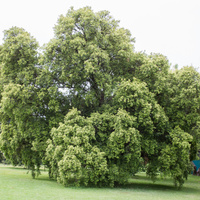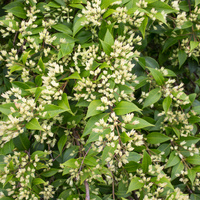Common name: Cinnamon myrtle
Other common names: Carrol, Carrol ironwood, Grey myrtle, Neverbreak, Ironwood
Description
Cinnamon myrtle is an ornamental and essential-oil yielding tree originating from Australia, its natural range extending along the east coast of the continent, from Bermagui in southern New South Wales to Fraser Island in central Queensland.
It is a small to medium-sized tree that reaches up to 12 m (40 ft) in its natural habitat, though it is typically 5 to 10 m (16 to 32 ft) tall with a stout trunk supporting a densely branched rounded crown. The bark is pale brown, vertically fissured and becoming scaly with age.
Leaves are oval to elliptical, 4 to 7 cm (1.6 to 2.7 in) long and tapering to a fine point. On top, they are dark glossy green underneath pale green and arranged in pairs along the ends of the branches. They remain on the tree throughout the seasons and give off a spicy, cinnamon-like aroma when crushed.
Flowers are small, creamy-white with long white stamens and bloom in summer in profuse clusters that almost hide the green foliage from view. Fertilised flowers develop into small, brown, star-shaped seed capsules with tiny seed inside. The seed are released when the capsules fall to the ground and split open.
Use
There are four known varieties or forms of Cinnamon myrtle, each yielding a distinct essential oil from its leaves, extracted by steam distillation. The four forms, Elemicin, Isoelemicin, Methyleugenol and Isoeugenol, are named after the chemical constituent that predominates in the oil.
Essential-oil yields range from 0.5 to 2.2% of the fresh leaves by weight, depending on the variety or form, growing conditions and the proportion of new to old-growth in the distilled material.
Methyleugenol and Isoeugenol are well-known and commonly used perfume materials. Similarly, Elemicin and Isoelemicin, which, when isolated, are used as modifiers and fixatives to create perfume blends and extend fragrance longevity. Elemicin is also the main constituent of Elemi oil, derived from the resin of the Elemi tree (Canarium luzonicum) and is a constituent of Nutmeg (Myristica fragrans).
The leaves, when crushed, can be rubbed on the skin as a natural insect repellent. They are also used to flavour desserts, confectionery, herbal teas, and locally produced gins in Australia.
The wood is hard, tough, close-grained and heavy, averaging around 1050 kgs per cubic meter (66 lbs per cubic ft). When sawn and seasoned, it develops an attractive pinkish-grey colour. However, the logs come diameters too small to make sawing them into lumber practical. Instead, the wood is crafted into handles for axes and other tools.
Health use
A leaf infusion is used in herbal medicine as a carminative to relieve flatulence or intestinal gas.
Climate
Grows naturally in warm temperate and subtropical rainforest climates, generally best in areas with annual lows of 9 to 17°C, annual highs of 19 to 29°C, annual rainfall of 700 to 2500 mm and a dry season of 3 months or less.
Growing
New plants are usually started from semi-hardwood cuttings. It performs best on rich, moist, free-draining soil of a mildly acid to neutral nature, generally with a pH of 5.5 to 7.0 and on sites in partial sun exposure. It has poor tolerance to alkaline, slow-draining or waterlogged soils.
Problem features
None know.
Where it grows
References
Books
-
Arctander, S. 1960, Perfume and flavor materials of natural origin, Elizabeth, New Jersey
-
Boland, D. & Brooker, I. & McDonald, M. W. 2006, Forest trees of Australia, 5th ed., CSIRO Publishing (Ensis), Melbourne
-
Cribb, A. B. & Cribb, J. W. 1982, Useful wild plants in Australia, William Collins, Sydney
-
Floyd, A. G. 1979, N.S.W. rainforest trees, 2nd. ed., Forestry Commission of NSW, Sydney, Australia
-
Weiss, E. A 2002, Spice crops, CABI Publishing, Wallingford, United Kingdom
Articles, Journals, Reports and Working Papers
-
Hegarty, M. P. & Hegarty, E. E. & Wills, R. B. H. 2001, Food safety of Australian Plant Bushfoods, Centre for Advancement of Food Technology & Nutrition, University of Newcastle, Rural Industries Research and Development Corporation (RIRDC), Australian Capital Territory



